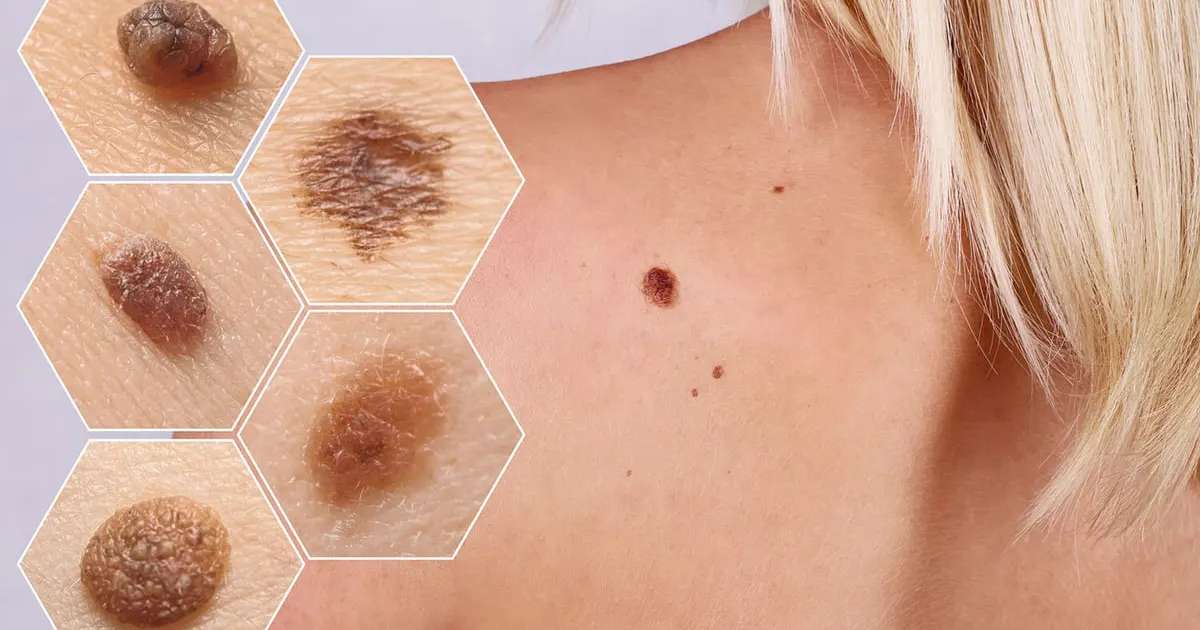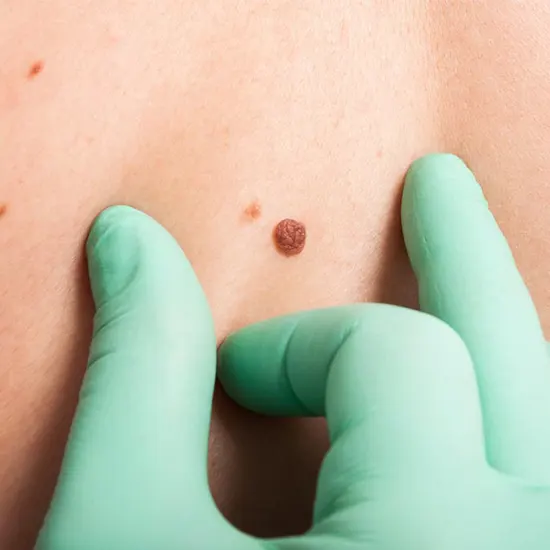
Skin cancer is a cancer type that starts in the cells of the skin. It occurs with abnormal cell growth. The skin cancer is of three types: basal cell carcinoma, squamous cell carcinoma, and melanoma.
Skin cancer is a cancer type that starts in the cells of the skin. It occurs with abnormal cell growth. The skin cancer is of three types: basal cell carcinoma, squamous cell carcinoma, and melanoma.
Types of skin cancer
- Basal Cell Carcinoma (BCC)
- Squamous Cell Carcinoma (SCC)
- Melanoma
Basal Cell Carcinoma (BCC) : Basal Cell Carcinoma (BCC) is the most common type of cancer of the skin that develops in the basal cells, which are responsible for producing new skin cells. BCC usually appears as a small, shiny, or pearly bump on the skin, or as a pink or red patch. BCC also looks like a scar or sore that doesn’t heal. It is most commonly found in the area that is exposed to the sun such as the face, scalp, ears, neck, and other areas. This cancer is slow-growing as well as rarely spreads to other body parts. However, if left untreated, it can grow larger and deeper, causing damage to nearby tissues and bones.
Squamous Cell Carcinoma (SCC) : Squamous Cell Carcinoma (SCC) develops in the flat cells that make up the outermost layer of the skin. This usually appears as a scaly, red, or brown patch, or as a wart-like growth. It is most commonly found in areas that are exposed to the sun, such as the face, ears, lips, and hands, but it can also develop in other areas of the body, such as the genitals and inside the mouth. It can spread to other parts of the body, but this is relatively uncommon. However, if left untreated, it can grow deeper and cause damage to nearby tissues.
Melanoma : Melanoma is the most dangerous type of skin cancer, but it is less common than BCC and SCC. This cancer type develops in the cells that produce pigment in the skin, called melanocytes. Melanoma can develop anywhere on the body even the areas that are not even exposed to the sun, such as the soles of the feet and the palms of the hands. Melanoma usually appears as a dark or unusual-looking mole or freckle, but it can also develop as a new spot on the skin. To identify the concerning features of melanoma such as asymmetry, border irregularity, variation in color, diameter larger than 6mm, etc, the ABCDE rule is used. Melanoma is more likely to spread to other parts of the body than BCC or SCC, and it can be deadly if it is not treated early.
_1680082245.webp)
Skin cancer can vary in appearance and behavior, so it's always a good idea to have any suspicious-looking or changing skin lesions evaluated by a dermatologist. Regular self-examination and annual skin check with a dermatologist are recommended for early detection of skin cancer.
Stages of skin cancer
The stages of cancer in the skin are determined by how deep the cancer has grown into the skin and whether it has spread to other body parts or not. The staging system for skin cancer is called the TNM system, which stands for Tumor, Nodes, and Metastasis.
Here's a brief overview of the stages:
Stage 0 : This stage is considered a very initial form of cancer of skin. It is also known as carcinoma in situ, and it refers to abnormal cells that are still confined to the top layer of skin, without invading deeper tissue.
Stage I : At this stage, the tumor has grown into the second layer of skin but is less than 2 mm thick. The tumor has not spread to any nearby lymph nodes or other body parts.
Stage 2 : The tumor has grown into the dermis and is larger than 2 mm, but has not spread to surrounding body parts or lymph nodes.
Stage 3 : At this stage, the tumor has grown and spread to the nearby lymph nodes but not to any other body part.
Stage 4 : At this stage, the skin cancer is known as metastatic skin cancer. This stage of cancer spread to other parts of the body such as the lungs, bones, brain, etc.
The prognosis and treatment of skin cancer depend on the stages as well as other factors such as age, skin cancer type as well as the overall health of the patient. The initial level of detection of skin cancer is crucial for the best treatment outcomes.
Symptoms of Skin Cancer
The symptoms of skin cancer depend on the type and stage of the skin cancer. Here are some general symptoms of skin cancer you need to watch are:
- A new spot on the skin
- A spot that changes in size, shape, and color
- A sore that doesn’t heal over the time
- Scaly or crusty patch of the skin that persists.
- A mole that bleeds, becomes itchy
- The change in the size, color, shape, or texture of the mole
- Scaly, flat, and itchy or crusted lesion
- A shiny or pearly bump on the skin is basically on the area that exposes it to the sun such as the face, neck, or hands.
It is important to note that not all changes or lesions in the skin are cancerous. But all new changes in the skin need to be evaluated. The early detection and treatment of skin cancer are important for the improved outcome and for reducing the risks of the occurrence of skin cancer.
Causes of Skin Cancer
There are various causes of cancer of the skin. But the primary reason of skin cancer is overexposure to ultraviolet radiation (UV radiation) either from the sun or from any other artificial sources like tanning beds. The UV radiations damage the DNA in the cells of the skin which can lead to changes that cause the cells to grow out of control and form a cancerous tumor.
The other risk factors that can increase the likelihood of developing cancer of skin include
Fair Skin : Individuals with fair skin and light-coloured eyes, Blue or green eyes, and red or blonde hair always remain at higher risk of developing skin cancer because they are having less amount of melanin, which protects from UV Rays.
History of Sun Burn : Individuals with a history of severe levels of sun burns and one or more blistering are at higher risks of developing skin cancer, especially in the case of sunburn in childhood.
Family History : Because skin cancer runs in families, individuals with a family history of skin cancer are at higher risk of developing cancer of the skin.
Age : As we grow the risk of developing skin cancer increases. Because the cells of the skin are not able to repair DNA properly over time.
Weakened immune system : People with weakened immune systems, such as those with HIV/AIDS or who have had an organ transplant, are at higher risk of developing skin cancer.
Radiation exposure : Exposure to radiation, such as during radiation therapy for cancer, can increase the risk of developing skin cancer in the treated area.

While some risk factors for skin cancer, such as fair skin and family history, cannot be changed, practicing sun safety and avoiding artificial sources of UV radiation can help reduce the risk of developing skin cancer.
Prevention of Skin Cancer
There are various steps that you can take to reduce the risk of developing skin cancer such as:
Use sunscreen : Apply a broad spectrum of sunscreens with an SPF of a minimum of 30 to all exposed skin and reapply the same every two hours, especially in the case of swimming or sweating.
Seek Shades : Avoid being in direct sunlight during the peak time (10 am to 4 pm) and seek shades under the trees, umbrellas, etc.
Wear protective clothing : Wear protective cloths such as long- sleeved shirts, pants, hats etc. to cover your skin completely.
Avoid tanning beds : Because the tanning beds releases UV radiation. The UV radiations causes skin damage and increase the risk of skin cancer.
Check your skin regularly : Monitor your skin for changes and report any new or changing spots to your doctor.
Stay hydrated : By drinking a lot of water, you can keep your skin hydrated and healthy.
Eat a healthy diet : A diet rich in fruits, vegetables, and whole grains can provide nutrients that support healthy skin.
Avoid smoking : Smoking can damage the skin and increase the risk of skin cancer, among other health problems.
By taking these steps, you can help protect your skin and reduce your risk of developing skin cancer. It's also important to see a dermatologist for regular skin exams, especially if you have a personal or family history of skin cancer or have other risk factors. Early detection and treatment of skin cancer can improve outcomes and reduce the risk of complications.
Diagnosis of Skin Cancer
The diagnosis of skin cancer usually involves a combination of physical examination, medical history, and sometimes a biopsy. Here are the steps involved in diagnosing skin cancer:
Physical examination : The doctor will examine the skin for any suspicious-looking spots or lesions. They will look at the size, shape, color, and texture of the spots and may use a dermatoscopy, which is a magnifying lens with a light, to get a closer look.
Medical history : The doctor will ask about any symptoms, risk factors, or previous skin cancer diagnoses.
Biopsy : If the doctor suspects skin cancer, they may perform a biopsy, which involves removing a small sample of the skin for examination under a microscope. There are several types of skin biopsies, including shave biopsy, punch biopsy, and excisional biopsy.
Laboratory analysis : The skin sample or blood sample for FISH analysis, will be sent to a laboratory for analysis by a pathologist, who will examine the cells under a microscope to determine if they are cancerous and what type of skin cancer it is. Apart from the FISH test, CBC and LDH are always recommended for extensive evaluation.
Imaging Tests : Once a diagnosis of skin cancer is confirmed, the doctor will determine the stage of cancer using the whole body pet scan and develop a treatment plan based on the type and stage of cancer, as well as the patient's overall health and other factors.
Conclusion
Cancer of the skin is a very common type of cancer that occurs when the cells of the skin grow abnormally. It is true about skin cancer can occur not only in areas that are overexposed to the sun but also in areas that are even not exposed to UV radiation. The early detection of skin cancer, its types, and its stages help in getting effective treatment.
For skin cancer screening, Ganesh Diagnostic offers a skin cancer screening package, that is helpful in getting a clear diagnosis and treatment of the condition. For any further queries, feel free to contact our expert healthcare executives.
















